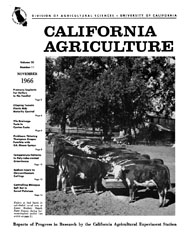


University of California
California Agriculture
|
|||
|
|||

Heifers at feed bunks in oak-shaded corral area at Roney Brothers Ranch, Butte County, during hormone- implant studies
November 1966
Volume 20, Number 11 |
|||
|
University of California, 1301 S. 46th St., Bldg. 478 Richmond, CA
|